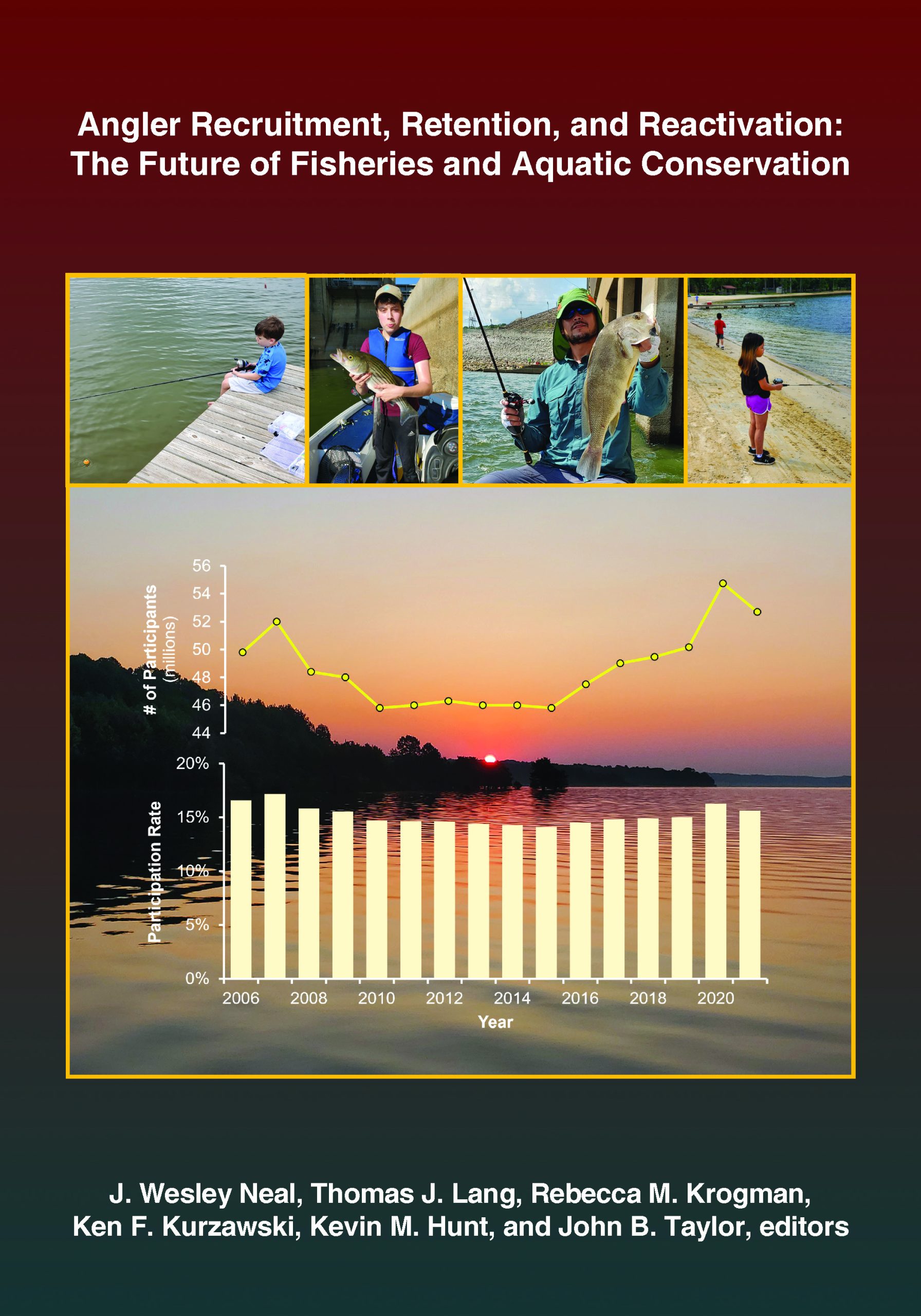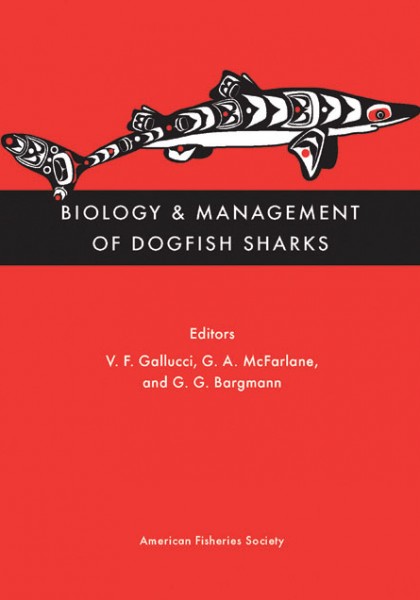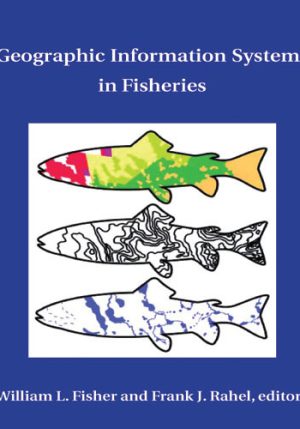Angler Recruitment, Retention, and Reactivation: The Future of Fisheries and Aquatic Conservation
$0.00 – $89.00
Description
J. Wesley Neal, Thomas J. Lang, Rebecca M. Krogman, Ken Kurzawski, Kevin M. Hunt, and John Taylor, editors
372 pp, hardcover
ISBN-13 . . . . . . . . . . . .978-1-934874-73-8
stock . . . . . . . . . . . . . . 550.88C
list price . . . . . . . . . . . $89.00
member price . . . . . . .$62.30
DOI: https://doi.org/10.47886/9781934874738
Published September 2023
Recreational angling is a crucial component of the management of aquatic resources. Angler expenditures create jobs and economic impact to local and regional communities, and contributions by anglers to nongovernmental organizations, excise taxes paid, and fishing licenses purchased provide funds to support conservation of aquatic species and habitats. Therefore, stagnation or decline in angling participation in many locations is a major concern to management agencies and threatens to erode the political and economic support for recreational fishing. To combat these concerns, fishery management agencies are actively engaging in recruitment, retention, and reactivation efforts designed to stop the decline and begin to regrow the angling population. Angler Recruitment, Retention, and Reactivation: The Future of Fisheries and Aquatic Conservation represents a comprehensive evaluation of how fisheries conservation is conducted and funded within the context of the current paradigm. Further, it explores potential for expanding or even replacing that paradigm with a more inclusive model. The text is divided into four sections with associated chapters. The first section addresses the history and importance of angling in North America and worldwide, including discussion of the role of anglers in development of policy and legislation. The next section explores how anglers think and make choices and includes exploration of angler behavior, diversity, and ethics. The third section is a study of recruitment and retention strategies, including using traditional and social media, reaching underrepresented demographics, incorporating data analytics, and a discussion of current efforts in recruitment. The book concludes with a thought-provoking consideration of alternative strategies, such as engaging nonanglers, developing novel partnerships, introspective agency transformation, and alternative funding models. Each chapter is intended as a starting point for its respective topic. There is never a one-size-fits-all approach in fisheries, so the general discussions are supported with ample literature for further exploration.
Preface | ix
Contributors | xi
Acknowledgments | xv
Symbols and Abbreviations | xvii
I. HISTORY AND IMPORTANCE OF ANGLING
J. Wesley Neal and Douglas J. Austen
1.1 Introduction | 3
1.2 What is the North American Model of Wildlife Conservation? | 4
1.3 Criticisms of the Model Concept | 8
1.4 Fisheries and the Angler’s Traditional Role | 10
1.5 The Conservation Funding Challenge and Relevance of the Model to Aquatics | 13
1.6 Conclusions | 20
1.7 References | 20
Robert Arlinghaus, Øystein Aas, Josep Alós, Ivan Arismendi, Shannon Bower, Steven Carle, Tomasz Czarkowski, Kátia M. F. Freire, John Hu, Len M. Hunt, Roman Lyach, Andrzej Kapusta, Pekka Salmi, Alexander Schwab, Jun-ichi Tsuboi, Marek Trella, Daryl McPhee, Warren Potts, Arkadiusz Wołos, and Zi-jiang Yang
2.1 Introduction | 25
2.2 The Life Cycle of Fisheries | 25
2.3 Global Recreational Fishing Participation and Its Drivers | 27
2.4 Environmental Ethics on Recreational Fisheries and Their Challenges | 34
2.5 Recreational Fisheries around the World | 43
2.6 Conclusions | 60
2.7 References | 62
Chapter 3. Angler Influence on Policy and Legislation
William M. Twardek, Nicolas R. W. Lapointe, Andy J. Danylchuk, Robert J. Lennox, Ryan Roberts, and Steven J. Cooke
3.1 Introduction | 75
3.2 The Management, Policy, and Legislative Framework | 77
3.3 The Actors and Their Role in Management, Policy, and Legislation | 79
3.4 Benefits of Engaging Anglers | 89
3.5 Risks of Engaging Anglers | 90
3.6 Mitigating Risks of Engaging Anglers | 91
3.7 Conclusion | 92
3.8 References | 93
II. DECIPHERING THE ANGLER MENTALITY
Kevin M. Hunt
4.1 Introduction | 101
4.2 Social Science in Fisheries Management | 101
4.3 Targeting New Constituents by Location | 104
4.4 Managing Resources for Underserved Constituents | 108
4.5 Conclusion | 110
4.6 References | 110
Len M. Hunt, Robert Arlinghaus, David Scott, and Gerard Kyle
5.1 Introduction | 113
5.2 Why Does Angler Diversity Matter? | 14
5.3 What Drives Angler Diversity? | 119
5.4 What Conceptualizations of Angler Diversity Exist? | 126
5.5 What Does the Future Hold for Angler Diversity? | 130
5.6 References | 133
Carena J. van Riper, Elizabeth Golebie, Cory D. Suski, Adam Landon, Richard Stedman, and Marc Gaden
6.1 Introduction | 141
6.2 Angler Behaviors Influence Fishery Resources | 142
6.3 Key Stewardship Principles for Resource Management Agencies | 143
6.4 Need for Wider Adoption of a Water Ethic | 147
6.5 Overcoming Challenges to Management of Aquatic Ecosystems | 148
6.6 Conclusion | 149
6.7 References | 149
III. RECRUITMENT AND RETENTION STRATEGIES
Roberto Gallardo, Stephanie W. Vatalaro, Rachael M. Carter, and J. Wesley Neal
7.1 Introduction | 157
7.2 Current Angler Recruitment Efforts | 157
7.3 Social Media | 164
7.4 Marketing a Rural Tourism Approach | 171
7.5 Putting It All Together | 174
7.6 References | 176
Rebecca M. Krogman, Susan A. Schroeder, Ramon Martin, and Richard Aiken
8.1 Introduction | 179
8.2 Factors Affecting Participation | 183
8.3 Targeting and Engaging Underrepresented Demographic Groups | 192
8.4 Conclusion | 207
8.5 References | 207
John Taylor, J. Warren Schlechte, Robert F. Otondo, J. Wesley Neal, and Nick Guild
9.1 Introduction | 217
9.2 A Marketing Approach to R3 | 219
9.3 Machine Learning Applications | 230
9.4 Improving R3 with a Business Approach in Texas | 236
9.5 Conclusions | 243
9.6 References | 244
Doug Darr, Andrew Branson, and Leslie Burger
10.1 Introduction | 249
10.2 Factors Contributing to Declining Angler Numbers | 249
10.3 Reversing the Decline | 250
10.4 Components of Angler Education Programs | 252
10.5 The Outdoor Recreation Adoption Model | 252
10.6 Program Planning and Implementation | 254
10.7 Evaluation of Program Success | 261
10.8 Conclusions | 264
10.9 References | 265
IV. ALTERNATIVE STRATEGIES FOR CONSERVATION
Nia Morales and Chelsey A. Crandall
11.1 Introduction | 271
11.2 Who Are Nonanglers? | 271
11.3 Role of Nonanglers in Conservation | 272
11.4 Engaging Nonanglers | 276
11.5 Conclusion | 284
11.6 References | 284
Thomas J. Lang
12.1 Introduction | 289
12.2 Benefits of Partnering | 289
12.3 Fundamentals of Partnerships | 291
12.4 Choosing the Right Partner | 296
12.5 Finalizing Selection and Establishing the Partnership | 298
12.6 Partnership Management | 300
12.7 Conclusion | 302
12.8 References | 302
Christopher Serenari and J. Warren Schlechte
13.1 Introduction | 305
13.2 Desired Ends: The Importance of Transformations and How to Analyze It | 308
13.3 Steps of Organizational Transformation | 309
13.4 Overcoming Challenges to Transformation through Design | 314
13.5 Conclusion | 322
13.6 References | 322
Rebecca M. Krogman, Timothy Birdsong, Brian Bohnsack, Ramon Martin, and Jenifer Wical
14.1 Introduction | 329
14.2 Current Status and Funding | 329
14.3 Diversifying Revenue | 336
14.4 Case Studies | 352
14.5 Conclusion | 355
14.6 References | 355
J. Wesley Neal, Tom Lang, Ken Kurzawski, Rebecca M. Krogman, Kevin M. Hunt, and John Taylor
Additional information
| Angler R3 | Complete Book (hard copy), Complete Book (PDF download), Complete Book (epub download), Front matter, 01 North American Model, 02 Global Participation, 03 Policy and Legislation, 04 Human Dimensions of R3, 05 Diversity of Anglers, 06 Beyond the Catch, 07 Using Media, 08 Underrepresented Groups, 09 Data Analytics, 10 Angler Education, 11 Nonangler Support, 12 Strategic Partnerships, 13 Agency Transformation, 14 Innovative Funding, Summary and Synthesis |
|---|







